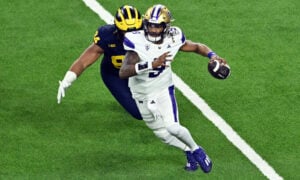Team-by-Team Draft Recap: Arizona Cardinals

The Cardinals had one of the best defenses in the league in 2013, but deficiencies on the offensive line held back their offense. The addition of offensive lineman Jared Veldheer in free agency should help in that area, so the Cards’ front office focused their attention on getting depth at the skill positions in the 2014 NFL Draft. Let’s cover those picks in today’s draft recap.
Troy Niklas, TE
If you would have asked me what I thought of Troy Niklas’ prospects as a fantasy tight end a couple months ago, my response certainly wouldn’t have been enthusiastic. Now that he’s in the desert, it’s lukewarm at best and it has nothing to do with the broken hand he suffered in OTA’s.
[am4show have=’p2;p3;p4;p5;p6;’ guest_error=’sub_message’ user_error=’sub_message’ ]
There are parts of Niklas’ game I really like –pPrimarily his size (6’6”, 270 pounds) and the way he towers over opposing linebackers and safeties. Another impressive part about Niklas is his athleticism, considering that size. Although he’ll never be considered fast (he reportedly ran a 4.85 second 40-yard dash while at Notre Dame), he consistently stretched the field on seam routes while in college. Lining up in the slot was also part of Niklas’ game in his final season playing for the Fighting Irish. Although he didn’t do it often, he looked smooth at the position and could develop into a weapon at the next level out of the slot. It’s also worth noting that he’s a very good blocker which should help him stay on the field, especially in the red zone.
With all that said, there are also reasons for dynasty owners to hesitate when considering Niklas in rookie drafts.
The most glaring hole in Niklas’ game is his route running. As I said above, he’s a good seam stretcher – but he should be. He ran it almost exclusively while at Notre Dame. In Arizona, he’ll have to run the entire route tree to become a solid contributor.
Niklas also has a tendency to let the ball get to his chest when making a catch which caused some drops in college but could be a problem at the next level with better coverage and bigger hits coming his way.
That brings us another shortcoming – his inability to make contested catches. While Niklas’ height allows him to sky over his opponents, the ball is often jarred loose when he’s hit while securing the catch or tucking it away which could become maddening in the pros.
The biggest thing holding Niklas back from becoming a dynasty asset was most evident at the combine. It wasn’t his 32 inch vertical, 27 reps on the bench press (which is impressive) or the fact he didn’t even run a 40-yard dash. In fact, it had nothing to do with what he did on the Lucas Oil Stadium turf.
It was what his future head coach Bruce Arians said at the podium.
“The tight end for me, I’m old school… tight ends for me block first, catch second,” Arians said. He added, “That’s why I loved Heath Miller. I still think Heath Miller’s the best tight end in the National Football League, not because he catches 90 passes, (but) because he blocks big defensive ends, and he catches about 60-70 passes.” (www.profootballtalk.com – February 21)
As an NFL tight end, Niklas looks solid. He’ll likely be one of the best blockers in the league at the position and should develop into a good red zone target for the Cardinals. As a fantasy tight end, it’d be surprising if he ever developed into more than a TE2. Although he does have the potential to improve considering his age (21) and relative inexperience at the position (he played his first year of college on defense and final two as a tight end), he shouldn’t be considered in rookie drafts until late in the third round at the earliest.
John Brown, WR
Brown’s game can be described in just one word. Fast.
Although he’s undersized at 5’10” and 180 pounds, Brown has one skill that can’t be taught – speed. He shined at the scouting combine with a 4.34 second 40-yard dash and the best 20-yard split among wide receivers, clocking in at 2.46 seconds. He has good hands and is extremely quick out of his breaks which suggests he could excel in the slot on Sundays. Brown also has a reputation as a hard worker who excels on special teams as a returner and gunner which will help him stick in Arizona early in his career.
With Ted Ginn scheduled to fill the void left by Andre Roberts as the third receiver for the Cards, it’s unlikely Brown will be expected to play a big role for Arizona’s offense as a rookie – although he could be asked to stretch the field as a situational deep threat early in his career. In the long term, because of his lack of size and strength, its unlikely Brown will carve a role any bigger than that of a part time offensive player. That said, he proved himself at FCS Pittsburgh State as a legitimate playmaker. With his work ethic and the fact that he’s already drawing praise from the coaching staff in Arizona, he’s worth monitoring over the coming months for dynasty owners.
Logan Thomas, QB
The Cardinals entered the draft with an obvious need for developmental signal caller behind 34-year old Carson Palmer – that’s exactly what they got when they selected Thomas in the fourth round.
When you look at Thomas on paper, he has all the skills you want in a franchise quarterback. He’s 6’6”, weighs 250 pounds and has very good athleticism, which was on display at the combine where he clocked in at 4.61 seconds in the 40-yard dash and displayed a 35 ½ inch vertical. Even more impressive is his arm strength. According to NFL Network, he was the only thrower to top 60 miles per hour in Indianapolis this year. Again, he looks like a franchise quarterback – on paper.
If you spend any time watching film of Thomas, you can immediately see why he lasted into round four of the draft. The first thing that jumps off the screen is how quickly (and often) he chooses to tuck the ball and run rather than sitting in the pocket and waiting for a receiver to uncover. Instead of keeping his eyes downfield and buying time with his legs, he immediately gets what he can with his athleticism – that mindset will no doubt cause problems for him at the next level.
When Thomas does stand in the pocket, goes through his reads and fire to a target, his arm talent is eye popping. The ball gets out of his hands fast and he has incredible zip on the ball. His accuracy isn’t great, but is improving – especially in the short to intermediate range.
Overall, Thomas is a talented, but very inconsistent developmental prospect for both the Cardinals and dynasty owners. He’ll likely take at least a couple seasons to mature behind Palmer, which makes him roster worthy in only the deepest of dynasty leagues. There is potential for him to become a franchise quarterback, but it will likely take an Aaron Rodgers-esque wait on the bench first. Unless you have the space to hold Thomas for at least a couple of seasons, leave him on the waiver wire.
Walter Powell, WR
The Cardinals took Powell in the sixth round of the draft. He’s a poor man’s version of John Brown, who they took three rounds earlier. Like Brown, he projects as a slot receiver in the NFL, but unlike Brown, Powell’s not fast (4.63 40-yard dash) and doesn’t look nearly as explosive.
Although Powell set school records at Murray State, catching 208 passes for 2,650 yards and 29 touchdowns to go along with three more scores on special teams, he’s a long shot to make the Cardinals’ roster. The chances of him making any type of contributions to a dynasty team are slim.
Follow me on Twitter: @dmeylor22
[/am4show]
- League Tycoon: Dynasty Salary Cap Fantasy Football - December 15, 2023
- Final Dynasty Rookie Report Card: Wide Receivers, Part Two - March 22, 2023
- 2023 NFL Scouting Combine: Offensive Player Dynasty Review - March 10, 2023


































































